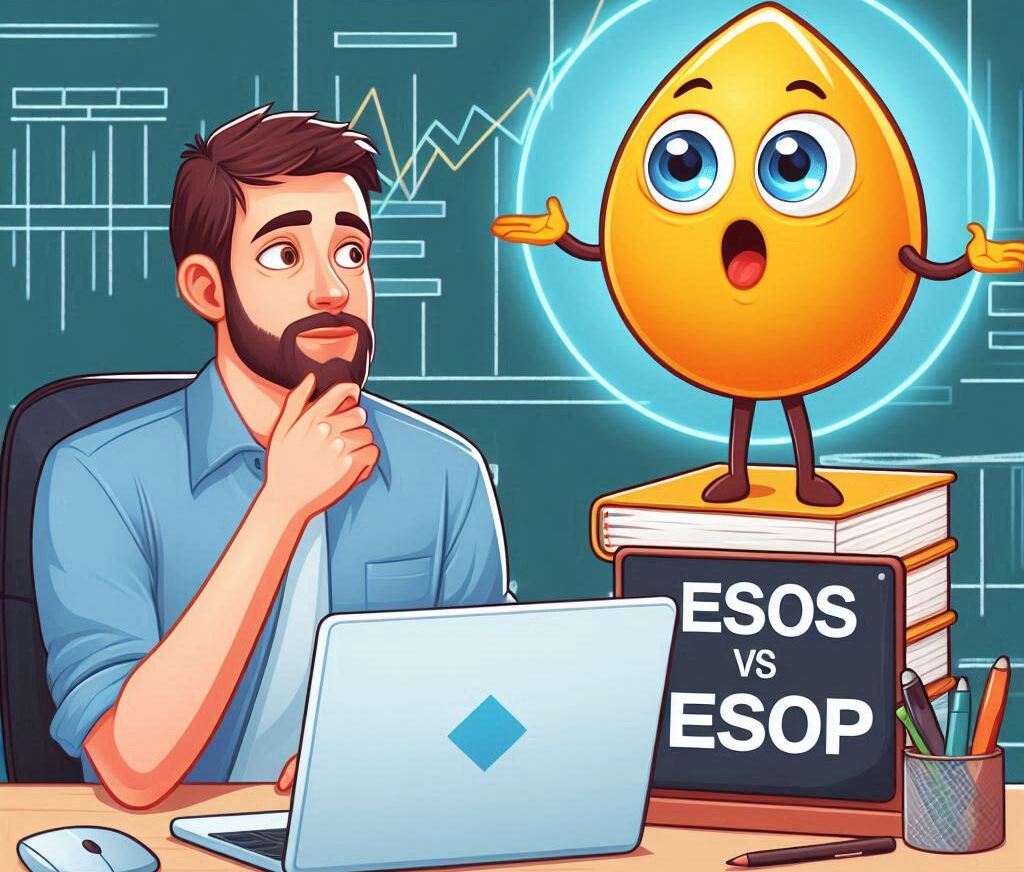Understand the difference between ESOS and ESOP. Learn about employee stock options schemes (ESOS) vs. employee stock ownership plans (ESOP) and their benefits.
Employee stock options are a popular incentive used by companies to attract and retain top talent. They come in different forms, with two of the most common being Employee Stock Option Schemes (ESOS) and Employee Stock Ownership Plans (ESOP). While they may sound similar, they serve different purposes and have distinct structures. This article delves into the key differences between ESOS and ESOP, their advantages, disadvantages, and their impact on both employees and employers.
What is ESOS?
Employee Stock Option Schemes (ESOS) are a form of equity compensation granted to employees, giving them the right to purchase company shares at a predetermined price after a specified period, known as the vesting period. ESOS are designed to align the interests of employees with those of the company’s shareholders by providing an incentive for employees to work towards increasing the company’s share value.
Key Features of ESOS
Vesting Period: Employees must wait for a certain period before they can exercise their options. This period, known as the vesting period, can range from a few months to several years.
Exercise Price: The price at which employees can purchase the shares, typically set at the market price at the time the options are granted.
Exercise Period: The time frame during which employees can exercise their options once they have vested. If the options are not exercised within this period, they may expire.
Lock-in Period: In some cases, there might be a lock-in period during which employees cannot sell the shares they acquire.
Advantages of ESOS
Employee Motivation: ESOS can motivate employees to contribute to the company’s success, as they stand to gain financially from an increase in the share price.
Retention: The vesting period helps retain employees, as they must stay with the company for a certain period to benefit from the options.
No Immediate Cash Outflow: Companies do not have to pay employees immediately; instead, they grant options that may convert into shares later.
Disadvantages of ESOS
Market Risk: The value of the options depends on the market price of the shares, which can fluctuate.
Complexity: ESOS can be complex to manage and understand, requiring clear communication to employees.
Dilution: Issuing new shares to fulfill ESOS can dilute existing shareholders’ equity.
What is ESOP?
Employee Stock Ownership Plans (ESOP) are a type of employee benefit plan that provides employees with ownership interest in the company. Unlike ESOS, where employees have the option to purchase shares, ESOPs involve the company directly allocating shares to employees, typically at no upfront cost to the employee.
Key Features of ESOP
Ownership Transfer: Employees receive shares directly, usually through a trust fund established by the company.
Eligibility and Allocation: Companies set criteria for eligibility and determine how shares are allocated among employees.
Vesting Period: Similar to ESOS, ESOPs often have a vesting period during which employees earn the right to the shares.
Tax Benefits: ESOPs often come with tax advantages for both the company and employees.
Advantages of ESOP
Employee Ownership: Employees become part owners of the company, which can enhance their commitment and loyalty.
Tax Benefits: ESOPs provide tax benefits, such as deferred taxation on shares until they are sold by employees.
Retirement Benefits: ESOPs can serve as a valuable part of employees’ retirement planning, providing long-term financial benefits.
Disadvantages of ESOP
Complex Administration: ESOPs require significant administrative effort to set up and manage.
Valuation Costs: Companies need to conduct regular valuations of their shares, which can be costly.
Liquidity Issues: Employees may face challenges in selling their shares, particularly in private companies where there is no active market for the shares.
Key Difference Between ESOS and ESOP
Purpose and Structure
ESOS: Primarily used as an incentive tool to motivate employees by granting them the option to purchase shares at a future date.
ESOP: Aimed at providing employees with ownership in the company, often as part of a broader employee benefit plan.
Ownership
ESOS: Employees do not immediately own the shares; they only have the option to purchase them in the future.
ESOP: Employees are allocated shares and become part owners of the company, usually through a trust.
Cost to Employees
ESOS: Employees need to purchase the shares at the exercise price, which involves a financial outlay.
ESOP: Shares are typically allocated to employees at no upfront cost, making it a more accessible form of ownership.
Tax Implications
ESOS: Employees may be taxed at the time of exercising the options and again when they sell the shares.
ESOP: Employees often enjoy tax deferral benefits, paying taxes only when they sell the shares.
Administrative Complexity
ESOS: While complex, ESOS is primarily focused on granting and exercising options.
ESOP: ESOPs require extensive administrative efforts, including setting up a trust, regular share valuations, and managing allocations.
Impact on Employee Motivation and Retention
ESOS: Motivates employees to contribute to share price growth, aligning their interests with shareholders.
ESOP: Fosters a sense of ownership and loyalty, potentially leading to higher employee engagement and retention.
Practical Examples of ESOS and ESOP
Example of ESOS
Consider a tech startup that wants to attract top talent. The company offers ESOS to new employees, granting them the option to purchase 1,000 shares at an exercise price of INR 100 per share. The options vest over four years, with 25% vesting each year. After four years, if the share price has increased to INR 200, the employees can exercise their options, purchasing the shares at INR 100 and potentially selling them at INR 200, realizing a significant profit.
Example of ESOP
A mature manufacturing company decides to implement an ESOP to give its employees a stake in the business. The company allocates shares to a trust, which then distributes the shares to employees based on criteria such as tenure and salary. Employees receive these shares without any upfront cost, and over time, they become vested in their ownership. Upon retirement or leaving the company, employees can sell their shares, often with substantial financial benefits.
Conclusion
Understanding the difference between ESOS and ESOP is crucial for both employers and employees. While both schemes offer unique benefits, they serve different purposes and suit different organizational needs. ESOS are ideal for startups and companies looking to incentivize employees with the potential for high rewards, whereas ESOPs are more suited for established companies aiming to foster long-term loyalty and provide substantial retirement benefits.
Monexo, a leading peer-to-peer (P2P) lending platform, can play a significant role in complementing these employee investment plans. By offering innovative financial solutions, Monexo can help employees diversify their investment portfolios and achieve their financial goals. Whether through P2P lending or other investment options, Monexo provides a reliable platform for employees to grow their wealth and secure their financial future.
In conclusion, choosing between ESOS and ESOP depends on the company’s objectives, financial situation, and the specific needs of its employees. Both schemes have their own set of advantages and disadvantages, and understanding these can help in making an informed decision that aligns with the long-term goals of the organization and its workforce.




